Vulnerability Analysis of Main Aftershock Sequence of Aqueduct Based on Incremental Dynamic Analysis Method
Abstract
1. Introduction
2. Incremental Dynamic Analysis (IDA)
2.1. IDA Method and Vulnerability Probability Model
2.2. Selection of Structural Performance Indicators
2.3. Determination and Division of Failure Grade Index
3. Finite Element Model and Calculation Parameters
3.1. Finite Element Model Information of Aqueduct
3.2. Selection and Structure of Main Aftershock Sequence Ground Motion
4. Results and Analysis
4.1. Dynamic Response of Aqueduct under Main Aftershock Sequence
4.1.1. Displacement Analysis
4.1.2. Damage Energy Dissipation Analysis
4.1.3. Damage Characteristic Analysis
4.2. Fragility Analysis
5. Conclusions
- (1)
- IDA curve clusters of the aqueduct structure under incremental dynamic analysis were established, and the reasons for the strong difference between the two IDA curve clusters were analyzed. For the aqueduct structure, the IDA curve, which takes the maximum ratio of the plastic strain energy to total deformation energy as the performance index, shows low discretization in the whole seismic time history and more accurately reflects the damage condition of the aqueduct. It provides a new structural damage index for the study of aqueducts.
- (2)
- Based on the main aftershock sequence of the structure, the dynamic response analysis of the maximum relative displacement, damage energy dissipation analysis, and loss characteristic analysis of the aqueduct shows that the residual displacement of the aqueduct increases by 33%, 66%, 44%, 37%, 0.01%, 60%, and 59%, respectively, under the effect of the aftershock. The incremental damage percentages at the end of the aftershock compared with the end of the main shock were 9.85%, 15.00%, 26.53%, 2.10%, 0.9%, 35.97%, and 9.85%, respectively.
- (3)
- Based on the IDA analysis results of the aqueduct structure, vulnerability curves under a single main shock and main aftershock sequence were established. By comparing the vulnerability curves under different earthquakes, it can be seen that the vulnerability curves drawn by the main aftershock sequence are larger than the vulnerability results of a single main earthquake, that is, the aftershock ground motion increases the risk of damage and destruction of the aqueduct, which is more unfavorable to the aqueduct structure.
Author Contributions
Funding
Data Availability Statement
Conflicts of Interest
References
- Li, H.; Xiao, S.; Huo, L. Damage investigation and analysis of engineering structures in the Wenchuan earthquake. J. Build. Struct. 2008, 29, 10–19. (In Chinese) [Google Scholar]
- Hoshiba, M.; Iwakiri, K.; Hayashimoto, N.; Shimoyama, T.; Hirano, K.; Yamada, Y.; Ishigaki, Y.; Kikuta, H. Outline of the 2011 off the Pacific coast of Tohoku Earthquake (M w 9.0)-Earthquake Early Warning and observed seismic intensity. Earth Planets Space 2011, 63, 547–551. [Google Scholar] [CrossRef]
- Zhang, J.; Zhang, S.; Zhang, Y.; Huang, L.; Li, Z. Ground motion vulnerability analysis of aqueduct structure based on Copula function. J. Vib. Meas. Diagn. 2019, 39, 8. [Google Scholar]
- Xu, X.Y.; Liu, X.; Jiang, L.; Ali Khan, M.Y. Dynamic Damage Mechanism and Seismic Fragility Analysis of an Aqueduct Structure. Appl. Sci. 2021, 11, 11709. [Google Scholar] [CrossRef]
- Omori, F. On the After-shocks of Earthquakes. Coll. Sci. Imp. Univ. Jpn. 1894, 7, 111–200. [Google Scholar]
- Gutenberg, B.; Richter, C.F. Seismicity of the Earth and Associated Phenomenon, 2nd ed.; Princeton University Press: Princeton, NJ, USA, 1954. [Google Scholar]
- Bath, M. Lateral inhomogeneities in the upper mantle. Tectonophysics 1965, 2, 483–514. [Google Scholar] [CrossRef]
- Utsu, T.; Ogata, Y. The centenary of the Omori formula for a decay law of aftershock activity. J. Phys. Earth 1995, 43, 1–33. [Google Scholar] [CrossRef]
- Shcherbakov, R.; Turcotte, D.L.; Rundle, J.B. A generalized Omori’s law for earthquake aftershock decay. Geophys. Res. Lett. 2004, 31, L11613. [Google Scholar] [CrossRef]
- Chen, K.C.; Wang, J.H. Correlations between the mainshock and the largest aftershock for Taiwan earthquakes. Pure Appl. Geophys. 2012, 169, 1217–1229. [Google Scholar] [CrossRef]
- Tahir, M.; Grasso, J.R.; Amorese, D. The largest aftershock: How strong, how far away, how delayed. Geophys. Res. Lett. 2012, 39, L04301. [Google Scholar] [CrossRef]
- Zhang, S.; Wang, G.; Sa, W. Damage evaluation of concrete gravity dams under mainshock–aftershock seismic sequences. Soil Dyn. Earthq. Eng. 2013, 50, 16–27. [Google Scholar] [CrossRef]
- Pang, R.; Xu, B.; Zhang, X.; Zhou, Y.; Kong, X. Seismic performance investigation of high CFRDs subjected to mainshock-aftershock sequences. Soil Dyn. Earthq. Eng. 2019, 116, 82–85. [Google Scholar] [CrossRef]
- Kong, X.; Zhou, Y.; Zou, D.; Xu, D. Study on aftershock record of Wenchuan Earthquake and aftershock response of Ziping faced rockfill dam. Chin. J. Geotech. Eng. 2008, 25, 134–139. [Google Scholar]
- Zhi, Z.; Zhai, C.; Bao, X.; Pan, X. Seismic capacity estimation of a reinforced concrete containment building considering bidirectional cyclic effect. Adv. Struct. Eng. 2019, 22, 1106–1120. [Google Scholar]
- Yang, F.; Wang, G. Research on damage Energy dissipation of RC Frame Structure under Main Aftershock sequence ground motion. World Earthq. Eng. 2019, 35, 45–52. [Google Scholar]
- GB 50011—2010; Code for Seismic Design of Buildings. China Architecture & Building Press: Beijing, China, 2010. (In Chinese)
- Zheng, X.; Hao, J.; Li, D. Seismic performance evaluation of gravity dam based on incremental dynamic analysis. South-North Water Divers. Proj. Hydraul. Sci. Technol. 2020, 18, 184–190. (In Chinese) [Google Scholar]
- Zhang, A.; Yang, S.; Jiang, Z.; Zhang, W.; Yang, X. Seismic vulnerability analysis of steel frame structures with replaceable lateral energy dissipation devices. Ind. Build. 2023, 1–13. Available online: https://kns.cnki.net/kcms/detail/11.2068.TU.20230224.1521.003.html (accessed on 14 May 2023).
- Zhao, J. Based on Seismic Performance of the Intake Tower for the Seismic Time History Method Research. Master’s Thesis, Xi’an University of Science and Technology, Xi’an, China, 2021. [Google Scholar]
- Li, J. Based on Viscoelastic Artificial Boundary of Gravity Dam Damage Analysis and Vulnerability Research. Master’s Thesis, University of North China Water Conservancy and Hydropower, Zhengzhou, China, 2022. [Google Scholar]
- Hao, J. Based on the Seismic Time History Analysis of the Intake Tower at the Top of the Structure Optimization and Seismic Performance Evaluation. Master’s Thesis, Hebei University of Engineering, Handan, China, 2020. [Google Scholar]
- Alembagheri, M.; Ghaemian, M. Seismic assessment of concrete gravity dams using capacity estimation and damage indexes. Earthq. Eng. Struct. Dyn. 2012, 42, 123–144. [Google Scholar] [CrossRef]
- Alembagheri, M.; Seyedkazemi, M. Seismic performance sensitivity and uncertainty analysis of gravity dams. Earthq. Eng. Struct. Dyn. 2015, 44, 41–58. [Google Scholar] [CrossRef]
- Liu, P.; Wang, C.; Zhang, J. Vulnerability analysis of high strength reinforced concrete frame under main aftershock. World Earthq. Eng. 2022, 38, 20–27. [Google Scholar]
- Sun, J.; Wu, J.; Lu, X. Study on seismic vulnerability of frame-supported multi-ribbed composite wall structures. Eng. Mech. 2023, 40, 61–72. [Google Scholar]
- Hatzigeorgiou, G.D. Ductility demand spectra for multiple near- and far-fault earthquakes. Soil Dyn. Earthq. Eng. 2010, 30, 170–183. [Google Scholar] [CrossRef]
- Liang, Y.; Yan, J.; Niu, H.; Li, J. Time-varying seismic vulnerability analysis of offshore pier considering main aftershock. J. Seism. Eng. 2019, 41, 8. [Google Scholar]
- Wen, W. Research on Damage Spectrum of Ground Motion Based on Main Aftershock Sequence; Harbin Institute of Technology: Harbin, China, 2011. [Google Scholar]
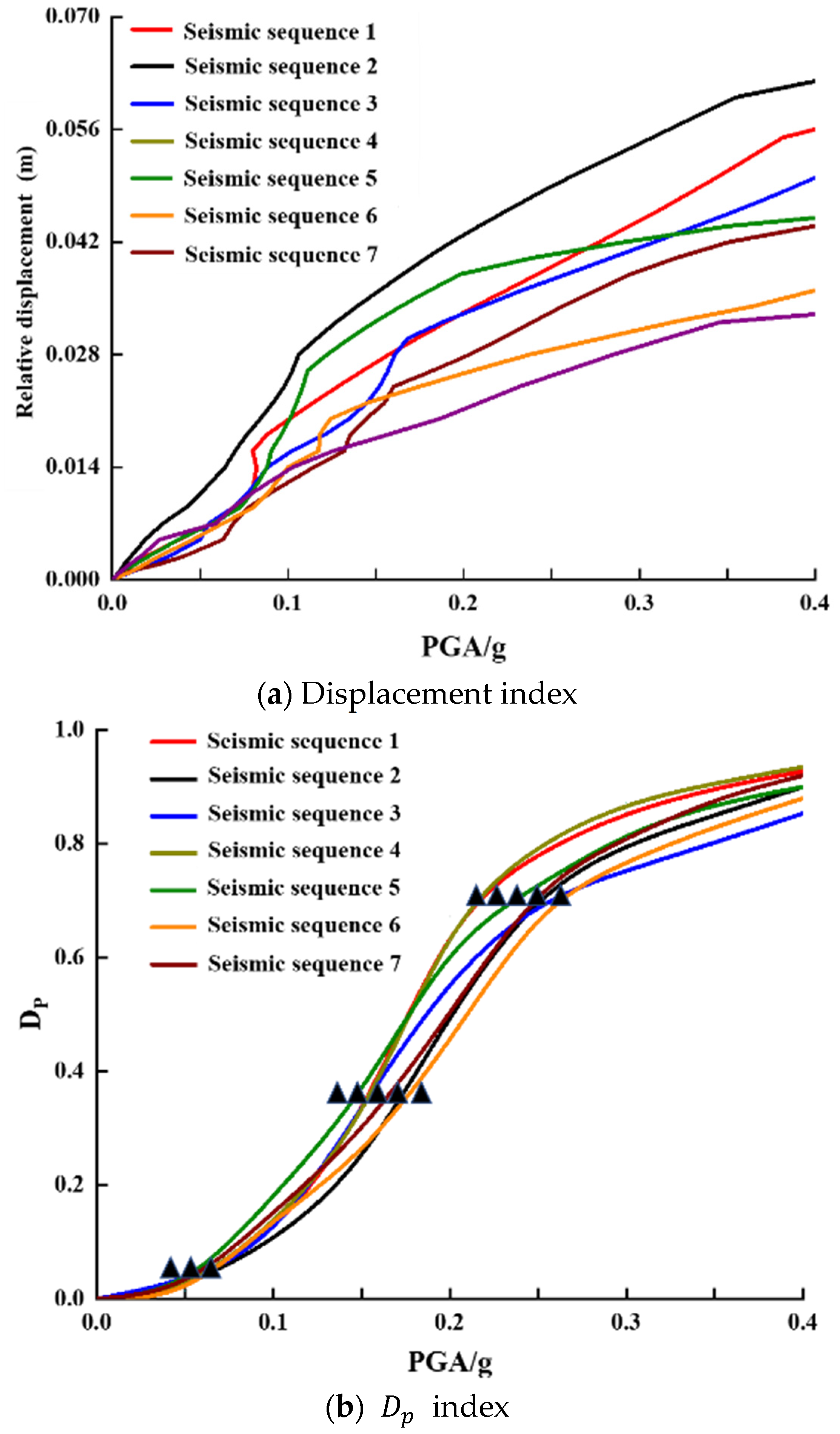
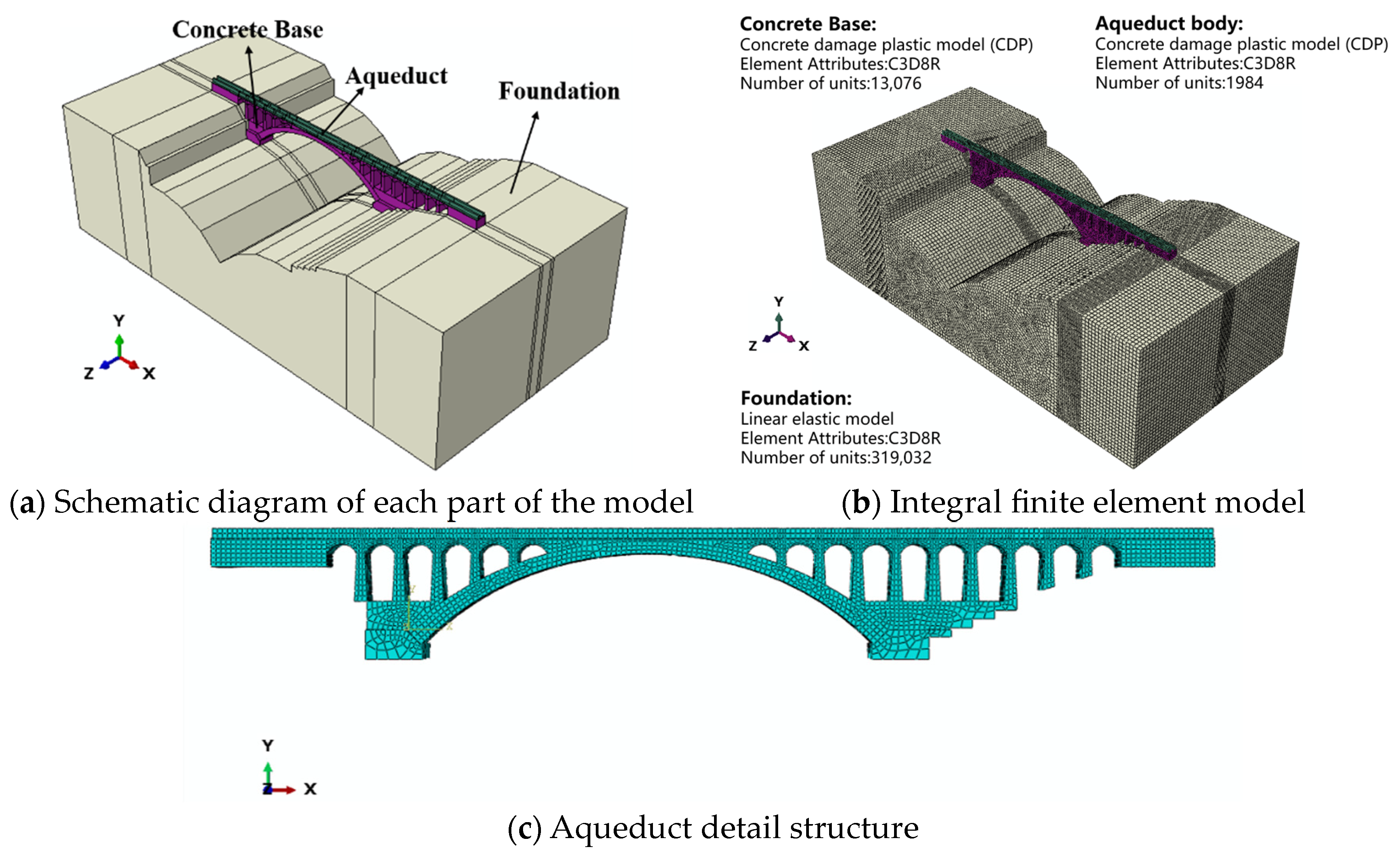
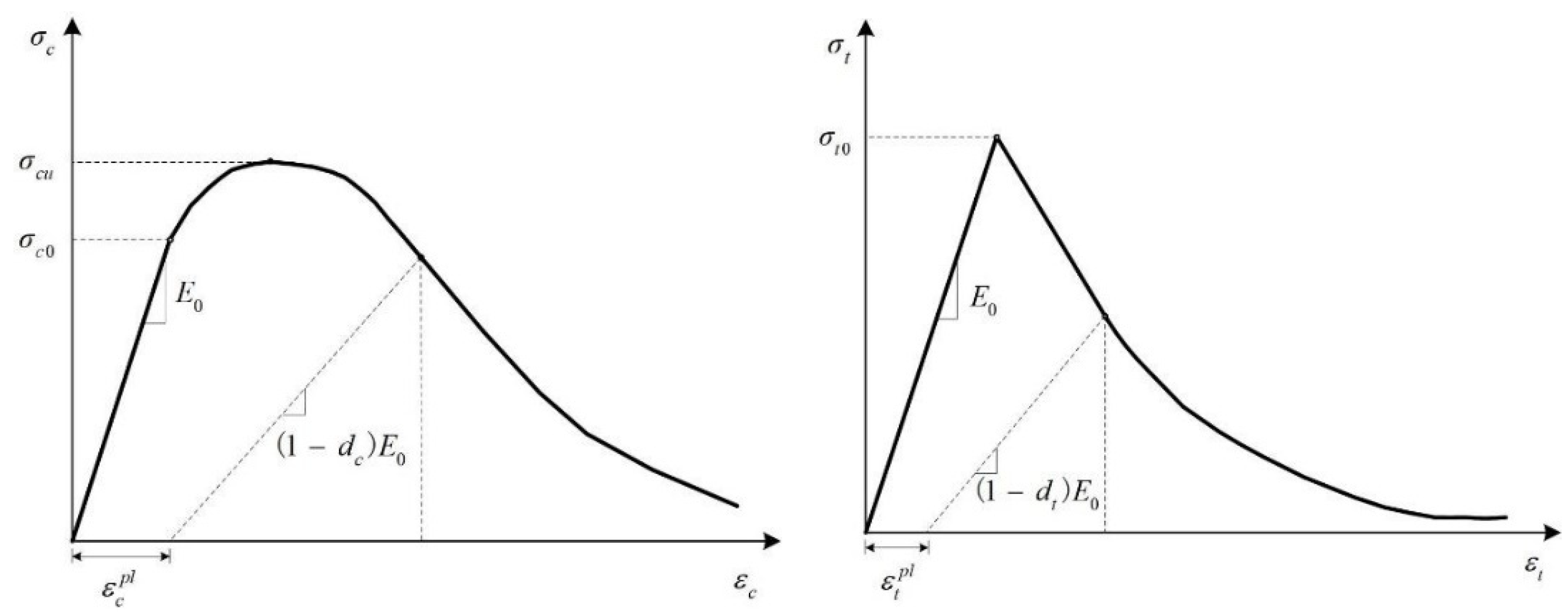
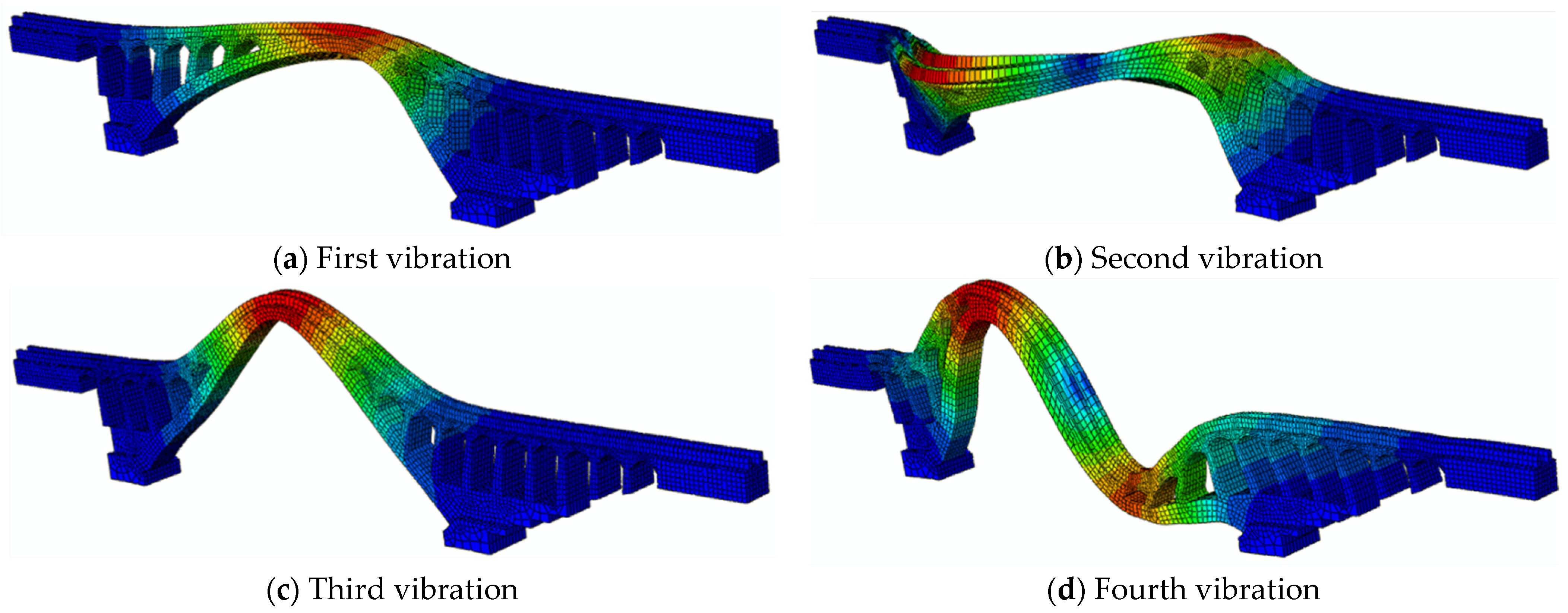
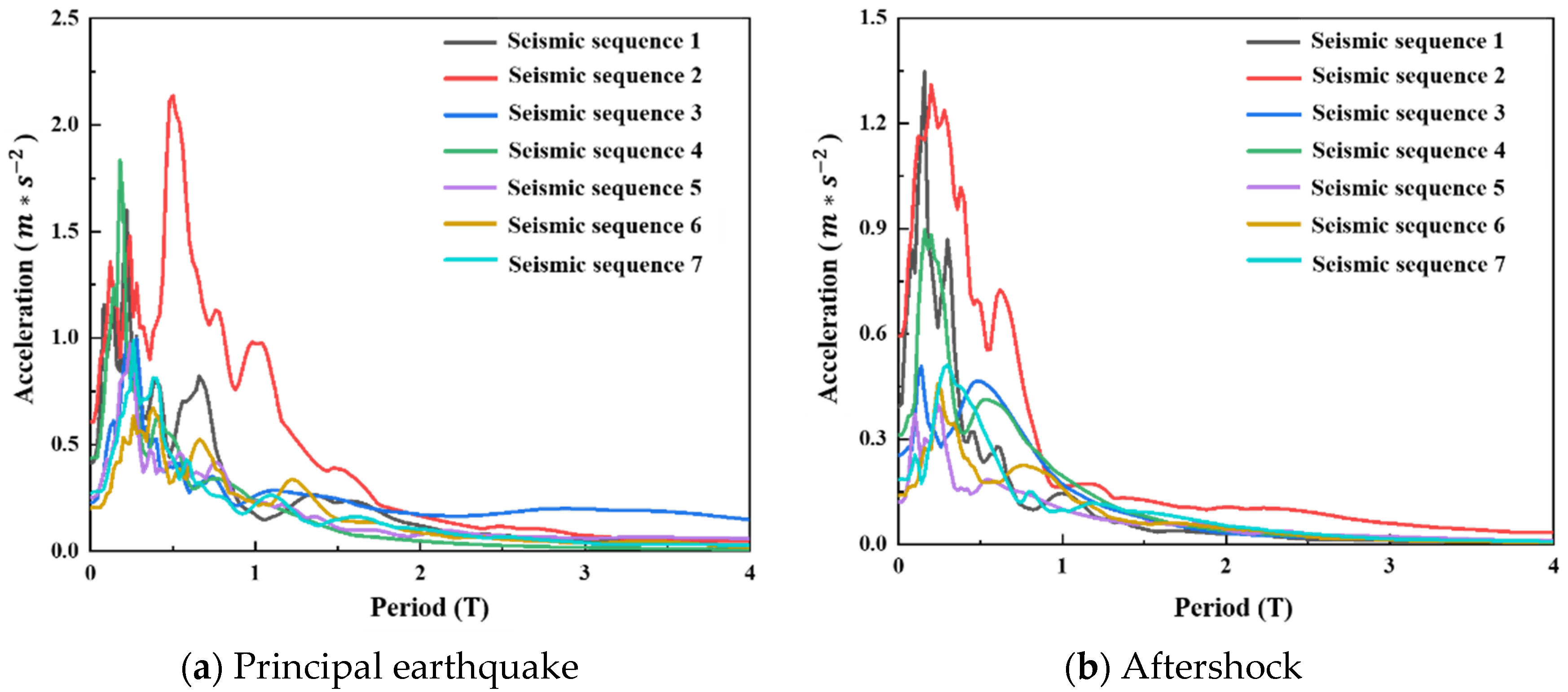
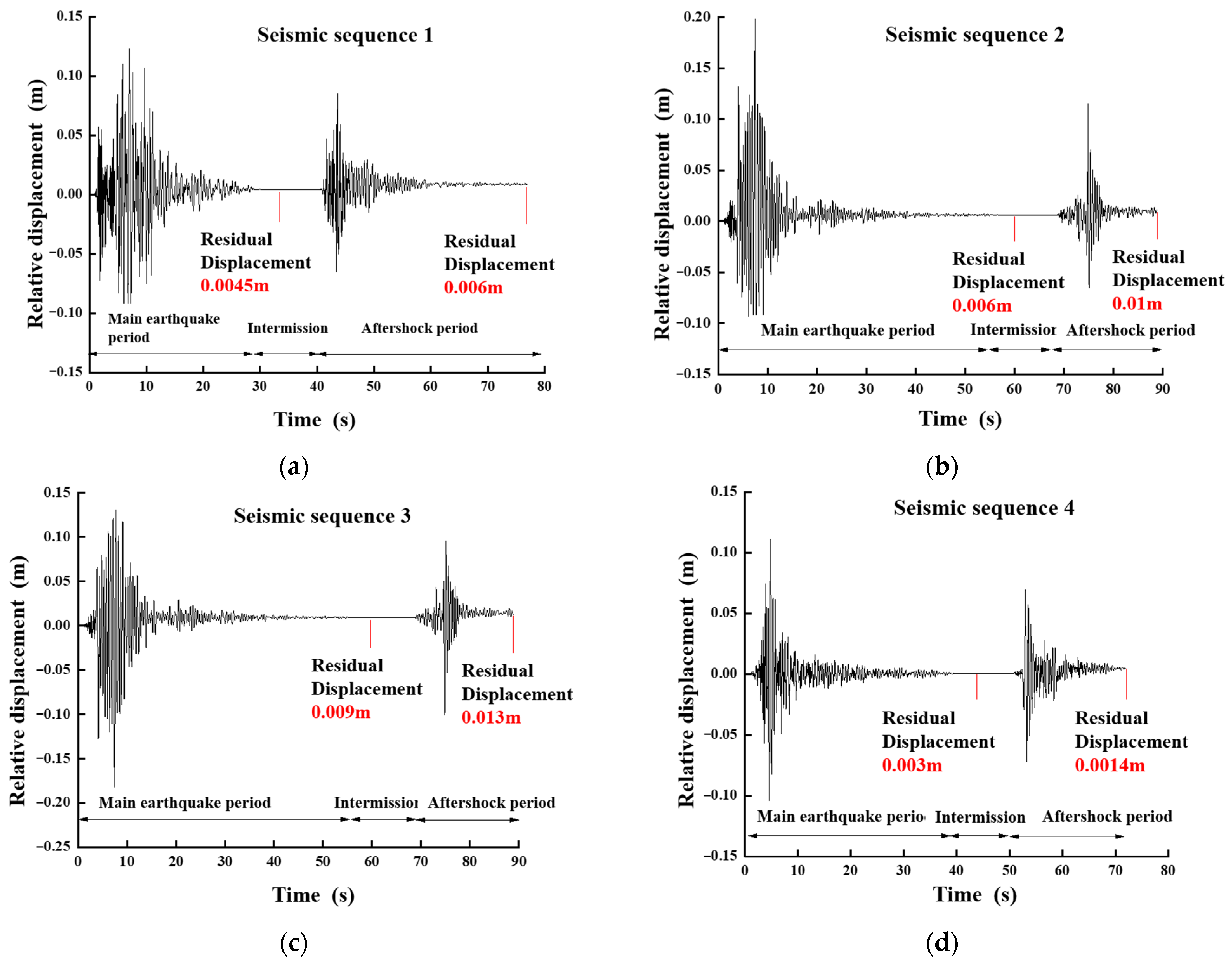
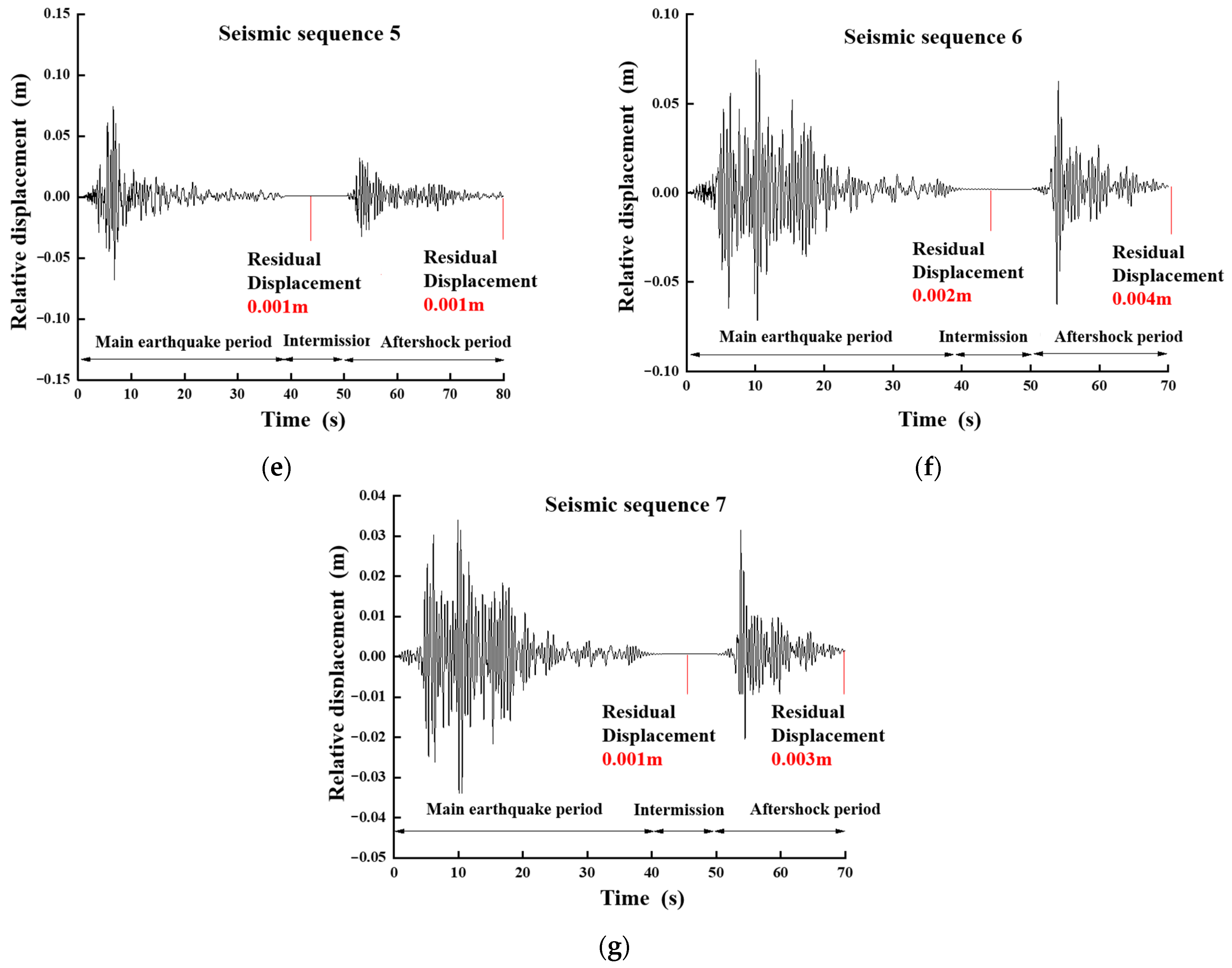
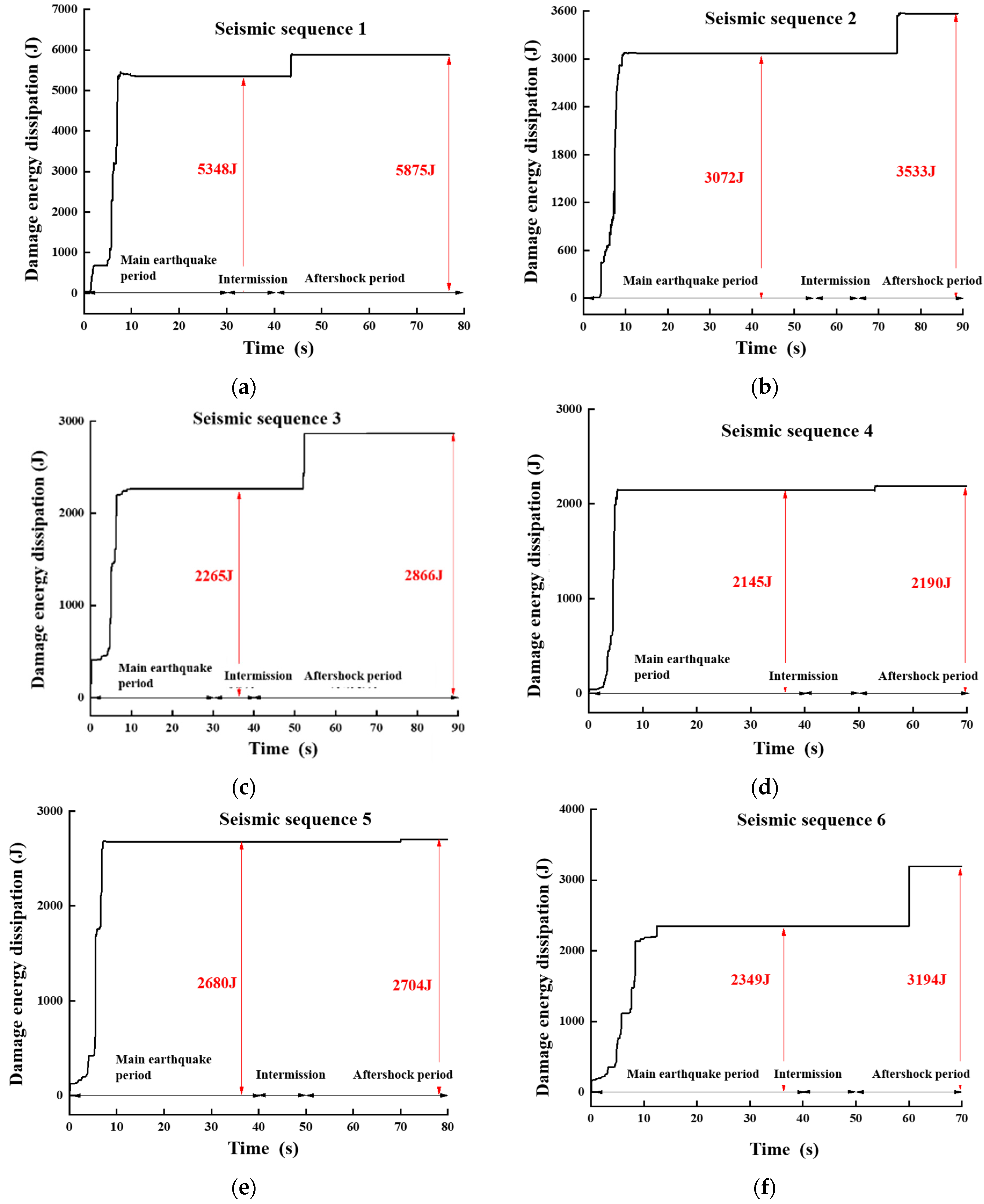
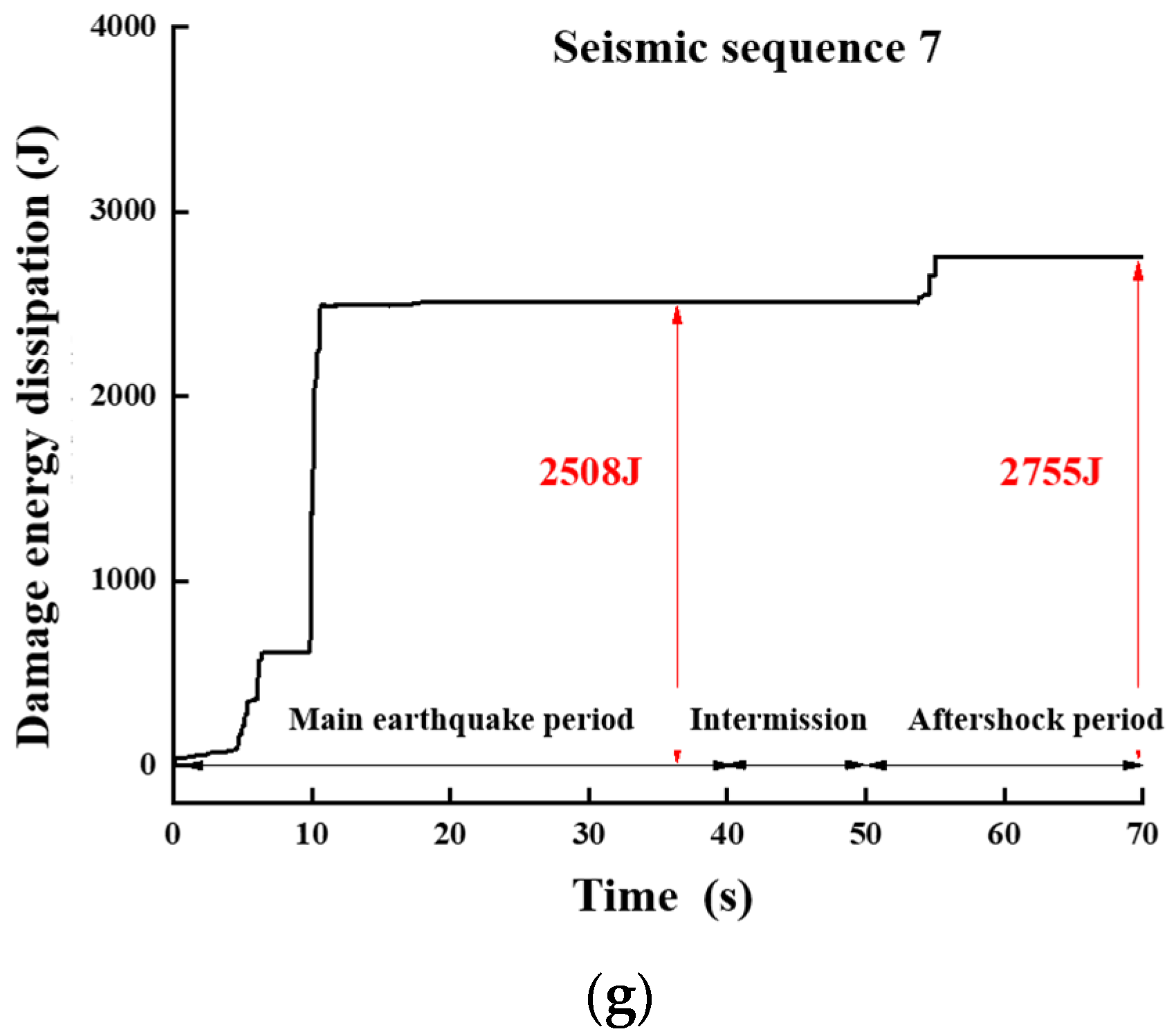


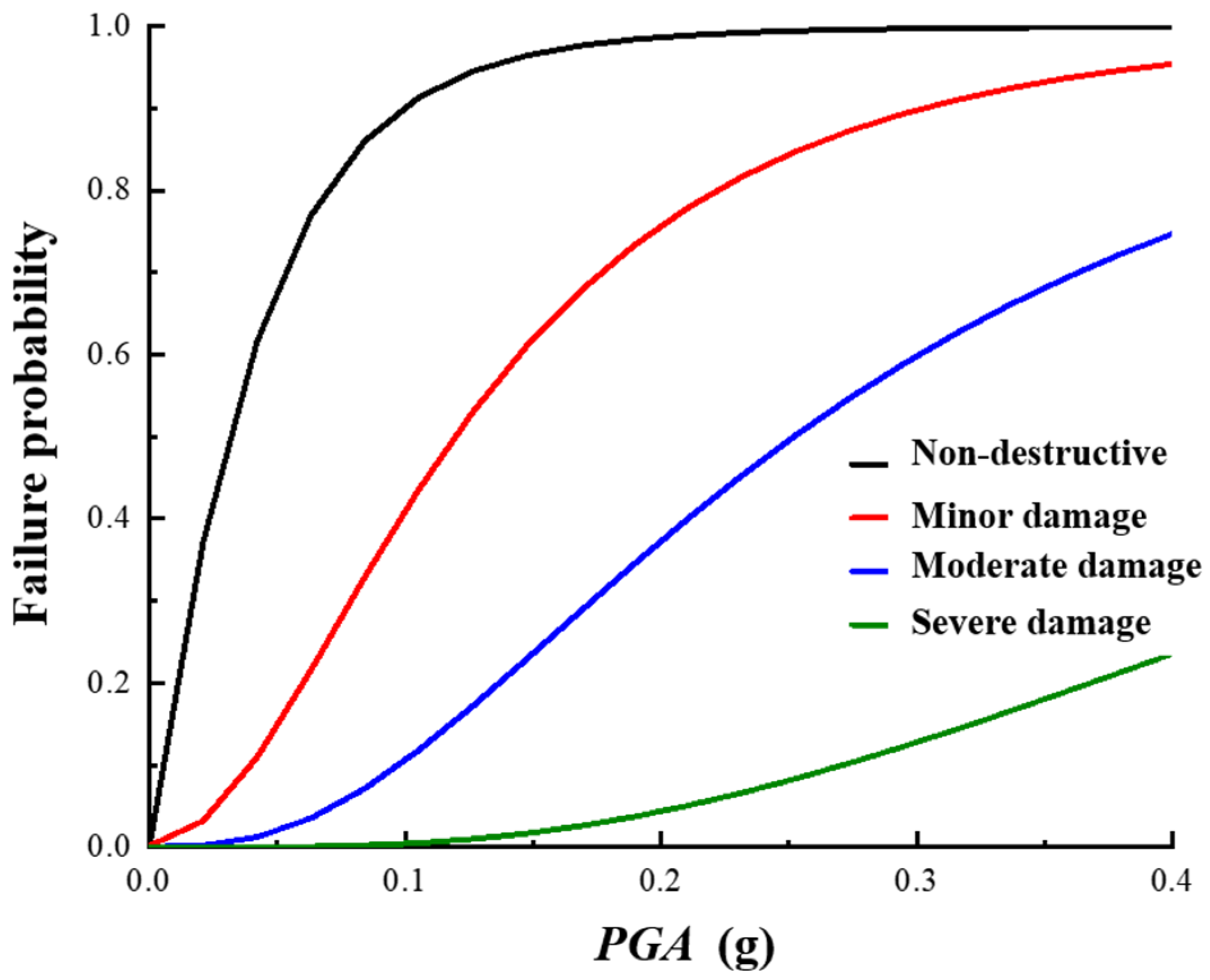
| Status Level | Minor Damage | Moderate Damage | Serious Damage |
|---|---|---|---|
| Peak acceleration | 0.05 g | 0.15 g | 0.25 g |
| 0.025 | 0.35 | 0.71 |
| Materials | Density (kg/m3) | Compressive Strength (Mpa) | Poisson’s Ratio | Damping Ratio |
|---|---|---|---|---|
| Aqueduct body (C70) | 2600 | 44.8 | 0.2 | 0.05 |
| Foundation (C20) | 2400 | 12.8 | 0.3 | 0.05 |
| Abutment (C25) | 2400 | 16.7 | 0.167 | 0.05 |
| Number | Name | Time | Earthquake Magnitude | Peak Acceleration |
|---|---|---|---|---|
| 1 | Mammoth Lakes | 25 May 1985 | 6.1 | 0.42 g |
| 5.7 | 0.37 g | |||
| 2 | Coalinga | 2 May 1983 | 6.4 | 0.61 g |
| 5.8 | 0.59 g | |||
| 3 | Imperial valley | 5 October 1979 | 6.5 | 0.22 g |
| 5.0 | 0.25 g | |||
| 4 | Whittier Narrows | 1 October 1987 | 6.0 | 0.44 g |
| 5.3 | 0.31 g | |||
| 5 | Chalfant Valley | 21 July 1986 | 6.4 | 0.25 g |
| 5.8 | 0.2 g | |||
| 6 | Narthridge | 17 January 1994 | 6.7 | 0.2 g |
| 5.9 | 0.14 g | |||
| 7 | Narthridge | 17 January 1994 | 6.7 | 0.27 g |
| 5.9 | 0.18 g |
Disclaimer/Publisher’s Note: The statements, opinions and data contained in all publications are solely those of the individual author(s) and contributor(s) and not of MDPI and/or the editor(s). MDPI and/or the editor(s) disclaim responsibility for any injury to people or property resulting from any ideas, methods, instructions or products referred to in the content. |
© 2023 by the authors. Licensee MDPI, Basel, Switzerland. This article is an open access article distributed under the terms and conditions of the Creative Commons Attribution (CC BY) license (https://creativecommons.org/licenses/by/4.0/).
Share and Cite
Zheng, X.; Shen, Y.; Zong, X.; Su, H.; Zhao, X. Vulnerability Analysis of Main Aftershock Sequence of Aqueduct Based on Incremental Dynamic Analysis Method. Buildings 2023, 13, 1490. https://doi.org/10.3390/buildings13061490
Zheng X, Shen Y, Zong X, Su H, Zhao X. Vulnerability Analysis of Main Aftershock Sequence of Aqueduct Based on Incremental Dynamic Analysis Method. Buildings. 2023; 13(6):1490. https://doi.org/10.3390/buildings13061490
Chicago/Turabian StyleZheng, Xiaodong, Yiming Shen, Xingguang Zong, Hui Su, and Xun Zhao. 2023. "Vulnerability Analysis of Main Aftershock Sequence of Aqueduct Based on Incremental Dynamic Analysis Method" Buildings 13, no. 6: 1490. https://doi.org/10.3390/buildings13061490
APA StyleZheng, X., Shen, Y., Zong, X., Su, H., & Zhao, X. (2023). Vulnerability Analysis of Main Aftershock Sequence of Aqueduct Based on Incremental Dynamic Analysis Method. Buildings, 13(6), 1490. https://doi.org/10.3390/buildings13061490





